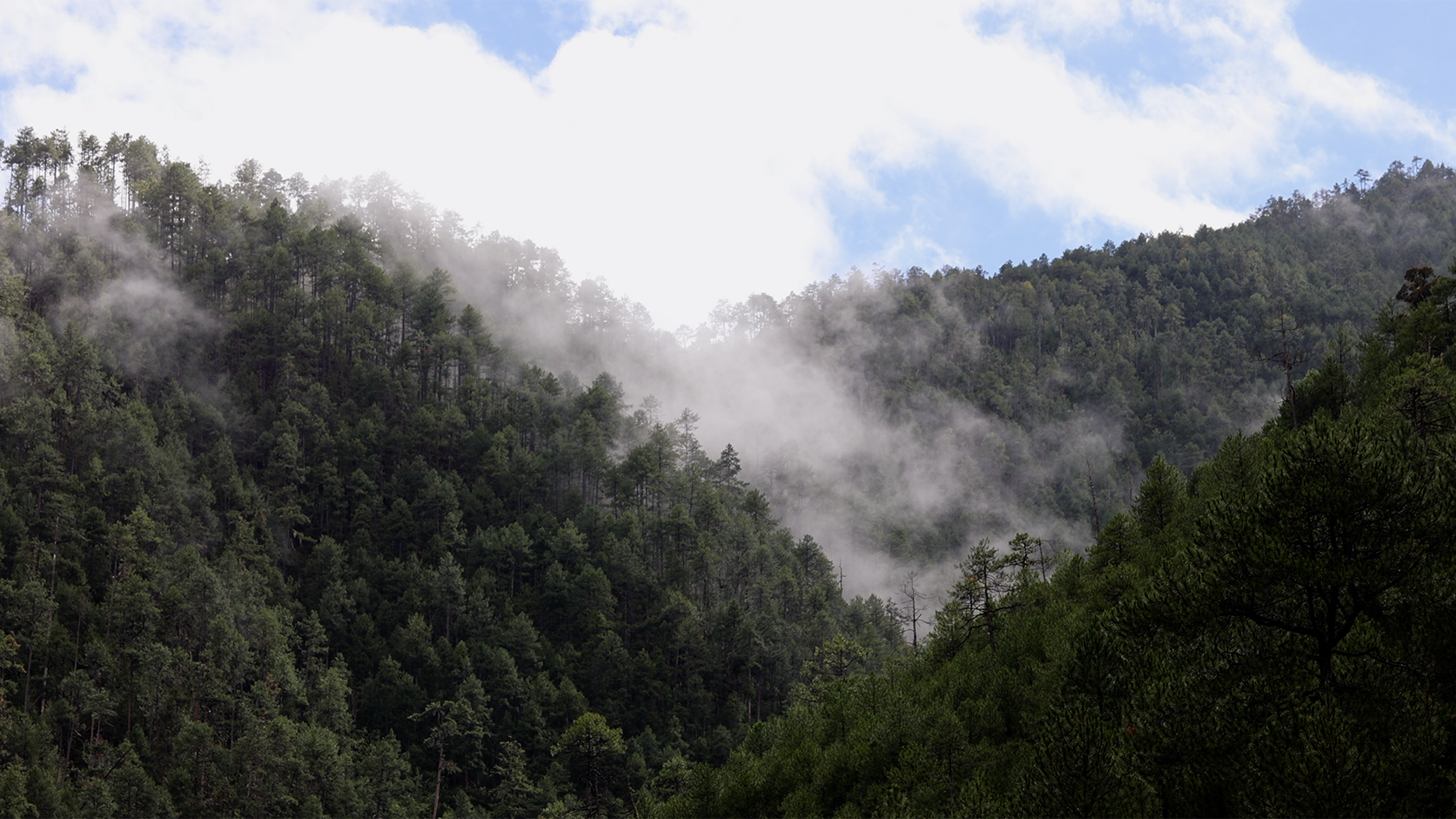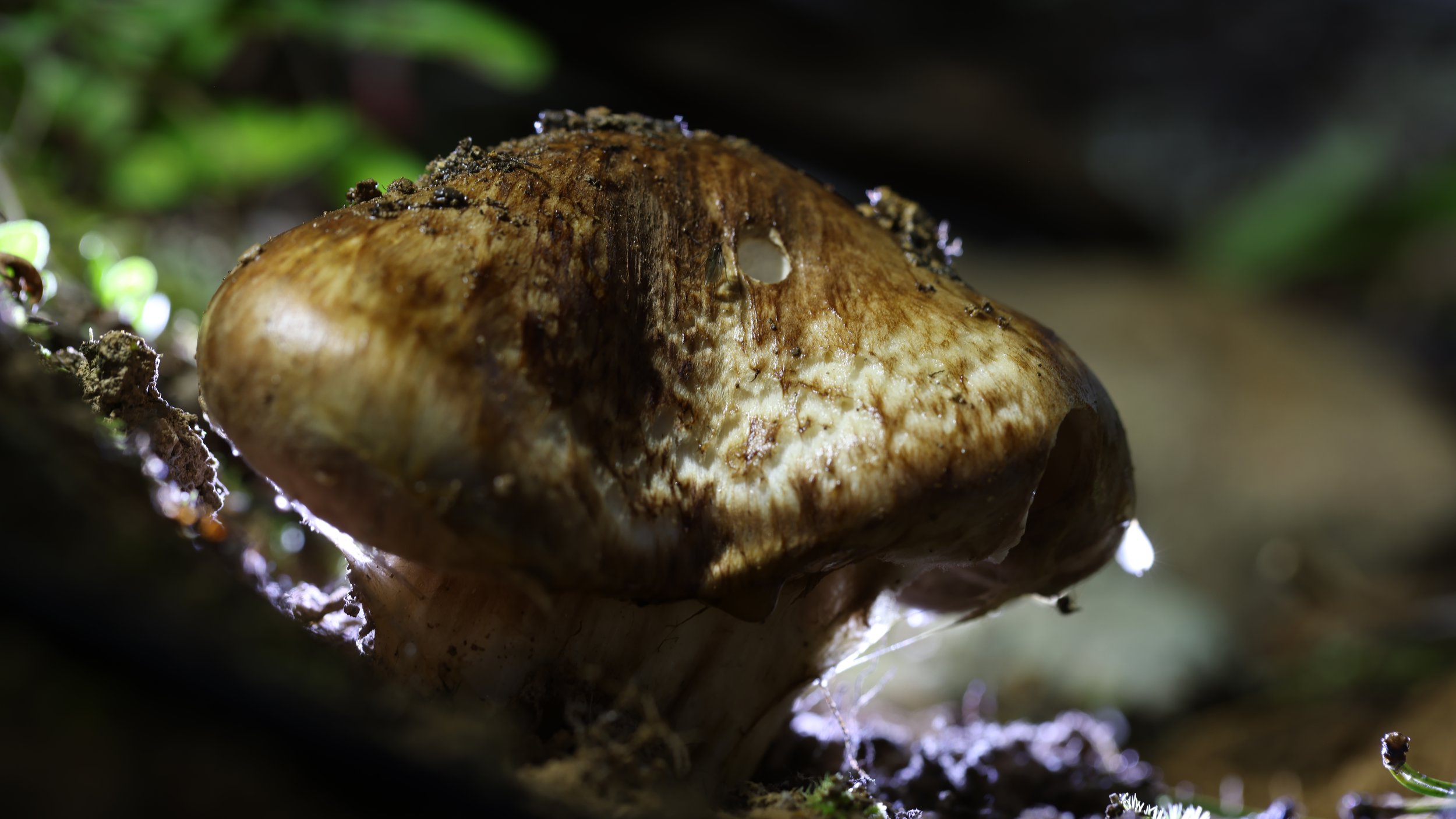松茸之雨——以一颗孢子的视角叙述松茸贸易线中人与森林的纠缠和关联
supported by M Art Fundation
In recent years, matsutake has received widespread attention as the subject of anthropological and global supply chain research. Intrigued by its symbiotic relationship with pine trees or attracted by its skyrocketing price driven up by human desire, fanatical “gold diggers” from different regions become connected through matsutake. The same is happening in Yunnan, China. The trade route of Matsutake connects Kunming, Chuxiong, Diqing, and Dali. People from various ethnic groups take on new identities and contribute to the transportation of matsutake mushrooms out of the forests [1]. Through the works of Anna Lowenhaupt Tsing and other anthropologists, we have already learned about the matsutake supply chain from a global and multispecies perspective. Is it necessary to retell the story of Yunnan? The answer is yes, because times have changed. How has the supply chain changed? How is the story of China different from other places? In particular, what is the connection between the abnormal fluctuation of the matsutake market in 2022 and climate change? These questions all warrant further investigation.
Since 1873, China has only issued 17 red alerts, three of which were issued in the summer of 2022 [2]. This June even witnessed the highest temperature recorded since the late 1850s [3], with the global mean surface temperature (GMST) reaching 1.15 ± 0.13°C above the pre-industrial baseline (1850-1900) [4]. According to a report by journalist Huang Yanhao published in the Caixin Weekly, “With the uncertainty in climate change colliding with the uncertainty in matsutake production, 2022 is expected to see a sharp drop on the fluctuating yield curve of matsutake… The decline in matsutake production is but a small annotation on the global heat this year” [5].
However, in the world of matsutake, it is not just an inconspicuous “annotation”. Matsutake is not a passive victim threatened by extreme heat, but a co-creator of nimbostratus clouds. While mushroom spores are as light as a puff of smoke, they can act as condensation nuclei that accelerate the transformation of water vapor into water droplets, thereby induing precipitation [6]. In this matsutake carnival taking place in human society, we see various players such as matsutake hunters, traders, gourmets, and sporocarps for sale. What is absent here? The mycelium beneath the soil and the dust-like spores, which are not easily detectable, but are the origin of matsutake’s existence and growth, the secret network of the pine forest. Therefore, we have to introduce a non-human narrative from the perspective of spores, allowing the absentees’ voices to be heard.
The floating and drifting of spores in air is not visible to the naked eye, but it is a real phenomenon. Observed at a microscopic scale, spores fall like rain in the forest, with a hint of sadness. Due to human intervention, the spores embarked on a new journey, which has changed the destiny of matsutake as well as the lives of “hunters”. Therefore, in my project “Matsutake Rain”, I filmed the moment when the spores were ejected. In the atmosphere set by a rain of spores, various encounters on this journey slowly unfolded – that is, narrating the entanglement and connection between humans and forests in the matsutake supply chain from the perspective of a spore.
Under the soil, the mycelium is deeply intertwined with the root system of pine trees, providing the plants with water and mineral nutrients such as nitrogen and phosphorus, while the plants providing carbohydrates in return [7]. As the fruiting body of mycelium, the sporocarp of matsutake plays a similar role to that of a reproductive organ, responsible for dispersing the spores from the mushroom cap to further locations in order to build new connections and obtain more nutrients. However, according to the grading system of the matsutake trade, only mushrooms with unopened caps qualify as high-grade. Therefore, during the matsutake harvesting season, countless treasure hunters rush to dig up every intact matsutake button they come across. Such a pursuit of unopened cap has led to the absence of spores in the matsutake growth cycle, because the fruiting body as the reproductive organ never matured enough to eject spores.
Sporulation is not easy. Although it takes less than a week for a pin to fully grow and the spore release only takes place during the last few days of pileus expansion, matsutake mycelium prefers growing on the roots of pine trees over 20 years old, and it takes more than three years for the first pin to be produced [8]. After a long growth period, the spores that should have been dispersed across the forest by wind were forced to change “course” due to their involvement in the human system of trade and commerce. Instead of air flows, the spores are now carried by human logistics services. Highly developed road networks and logistics systems not only help transport wood and minerals out of the mountains, but also facilitate the delivery of matsutake mushrooms to the dining tables around the world in the shortest time possible.
The fruiting bodies of matsutake decay quickly after harvest. Eating before they spoil is the key to preserving their value. This is why many suppliers advertise guaranteed 48-hour delivery. In just 48 hours, the embodiment of the forests will be delivered to you from some distant mysterious land, without the need to personally climb a thousand mountains and survive all the dangers along the way. In a tea house in Hangzhou, the chef takes a cold matsutake mushroom out of a gift box as if it’s a freshly delivered organ. With a sharp knife, he then cuts it into the iconic thin slices. From the slices, you can see the mushroom cap is still curled and folded, perhaps with some spores still stored on the gills. Here matsutake transforms into the embodiment of a distant “fairyland”, a “sacred object” that connects the city dwellers with the forests, and a “dream-making” tool of the consumer market. The spores, on the other hand, eventually fell into oblivion behind the fabricated illusion of the forests and ceased to grow.
For hunters, matsutake is a precious gift from the mountain gods, a bridge that connects people. Every family in the village knows an area of the mountains particularly well, and the location of fungal colonies is often passed down as a family secret. Sharing the location of fungal colonies with others and helping identify the type of fungus is an excellent way to gain others’ trust [1]. Matsutake mushrooms are like fairies that can only be encountered by chance. They love to play hide and seek with the hunters in the forest – matsutake mushrooms change where they grow every year. Harvested matsutake mushrooms will be delivered to the bulkers’ field agents by noon every day, who are not allowed to pick and choose, so that the risk and uncertainty caused by the lack of standardization of matsutake can be shared equally. Even at late night, the matsutake trading markets in Shangari-La and the wild mushroom trading markets in Kunming are still filled with bustling crowds. The bulkers’ shops are constantly packed with field agents whom they have known and worked with for years. The trust they have built accelerates the transactions, makes grading and pricing more efficient, and thereby gives humans an advantage in the race against time before the harvested matsutake mushrooms spoil.
This investigation into the circulation of matsutake mushrooms includes visiting the annual Matsutake Festival in Shangri-La; mushroom recording and picking in the mountains and forests; in-depth interviews with traders at the Matsutake Wholesale Market in Geza Town, Shangri-La Matsutake Trade Market, and Shuimuhua Wild Mushroom Trading Center in Kunming, Yunnan Province; first-hand experience at forest-to-table Tibetan restaurants located near matsutake mushrooms’ natural habitats, as well as that of Zen-inspired matsutake feasts served in high-end clubs in Jiangsu and Zhejiang Provinces… These stories were vividly narrated from the perspective of spores, because just as Robert Macfarlane writes in Underland: A Deep Time Journey, “Maybe, then, what we need to understand the forest’s underland is a new language altogether – one that doesn’t automatically convert it to our own use values… Perhaps we need an entirely new language system to talk about fungi… We need to speak in spores. [9]”
1. Matsutake, Mobility, and Class: A Socio-cultural Study of a Yi Ethnic Village, Zhang Ting, Minzu University of China, 2020
2. State of the Climate: 2022 on track for a summer of extreme heat, ZEKE HAUSFATHER, Carbon Brief, July 25, 2022
3. Blue Book on Climate Change in China (2022),National Climate Center of China Meteorological Administration, Science Press, Beijing
4. WMO Provisional State of the Global Climate 2022, World Meteorological Organization (WMO), Published by WMO, 2022
5. Decline in Matsutake Production: A Bite of Climate Change,Huang Yanhao,Caixin Weekly, August 2022.
6. Mushrooms as Rainmakers: How Spores Act as Nuclei for Raindrops, Maribeth O. Hassett, Mark W. F. Fischer, Nicholas P. Money. October 28, 2015
7. Entangle Life: How Fungi Make Our Worlds & Change Our minds & Shape Our Futures, Merlin Sheldrake, Random House, 2020
8. The Life History and Cultivation Methods of Matsutake, Yasuto Tominaga, Translated by Tan Wei, Sichuan Institute of Edible Fungi at Sichuan Academy of Agricultural Sciences, 1992
9. Underland: A Deep Time Journey, Robert Macfarlane, Translated by Wang Rufei. Wenhui Publishing House, 2021
近年松茸作为人类学和全球贸易链条的调查对象被广泛关注,或因它与松林纠葛的共生特性,或因人们对它的欲望使其身价暴涨,使得不同地域的狂热“淘金者”们通过松茸串联在一起。在中国云南也不例外,由松茸串起的贸易线路从昆明到楚雄,大理、迪庆,各民族群落的人们纷纷转变身份加入到将松茸运出森林的运动中[1]。通过罗安清和相关人类学者的著作中已经了解到全球多重视角下松茸贸易链上的故事,我们是否有必要再赘述云南的故事? 答案是肯定的,因为时过境迁,贸易链如今有怎样的变化?在中国的故事与他出又有什么不同?尤其2022年松茸业大幅波动的异常与气候变化存在怎样的联系?这些都值得继续被追问。
自1873年以来,中国只发布了17次红色预警,其中三次都在2022年夏天发布[2],甚至6月出现了自1850年代末开始记录以来最热的温度[3],GMST比工业化前基线(1850-1900)高1.15±0.13°C[4]。借用记者黄晏浩在《财新》周刊上的报道:“气候变化的不确定性撞上松茸的不确定性,在松茸产量的波动曲线里,2022年预计将成为一个尖锐的凹陷……松茸减产只是今年环球酷热的一个小小注解”[5]。
在松茸的世界里,它并不是一行不起眼的“注解”,它不是被高温威胁的被动方,它也是雨云的共创者。蘑菇的孢子轻如一阵烟,但它却可作为水汽的凝结核加速水滴的聚集,促进雨水的降落[6]。在这场人类社会中的松茸狂欢,我们随处可见形形色色的松茸猎人、交易商、品尝者与待售的子实体。但什么在其中是缺位呢?是土壤下的菌丝和与如尘的孢子,它们不易察觉,却是松茸存在和生发的本源,是隐于松林的纠缠网络。所以我们是否可以在这场因松茸而聚合的盛会,以孢子的视角带来非人类的叙述,让缺席者发声。
孢子在空中悠扬、微妙的飘动是非肉眼所能见,但却真切存在的景象。微观下孢子飘落的过程就像森林中下的一阵雨水,有些许轻盈、忧愁的情绪。 因为人类的介入,孢子拥有了不同的旅程,这趟旅程改变了松茸的命运,也改变了“猎人们”的生活。所以在松茸之雨的项目中,我通过拍摄松茸喷发孢子的时刻,在孢子雨营造的气氛下娓娓道来它不同旅程中遭遇的故事——即从一颗孢子的视角去叙述松茸贸易线中人与森林的纠缠和关联。
土壤下,菌丝深深与松树的根系交织在一起,为植物提供水分和氮、磷等矿质元素, 植物则为其提供碳水化合物[7]。而松茸作为菌丝的子实体,是近似于生殖器般的角色,其职责便是将伞盖中的孢子送往更远的地方,以建立更多新的联系、获取更多的养分。但在松茸贸易的分级机制中,只有未开伞才能定入高品级。所以在菌子季节的寻宝狂欢中,无数人焦急的赶在松茸开伞前的挖走每一朵遇见的小骨朵。这种对未开伞的追求致使孢子在松茸生长环节中的缺位,因为作为生殖器的子实体无法顺利生长到喷发孢子的时刻。
萌发孢子是不易的,虽然从菇芽发育到成熟用时不到一周,其中孢子喷发的时刻也只在伞盖打开的最后几天中。但松茸的菌丝只喜长在20岁以上的松树根部,而发育出第一颗菇芽还需要等待三年甚至更久的时间[8]。但经过漫长的生长,本应在森林中随着气流飘散的孢子却因卷入人类的贸易系统,而被迫改变了“旅行”的轨迹。孢子的飞行也从气流变为了人类的物流,发达的公路网络、物流系统不仅将木材、矿产运出大山,也将松茸以最短的时间置于某处的餐桌上。
离开土壤的子实体将迅速腐化,在其腐化前食用是松茸保价的关键,这也是为什么各路供货商们都高喊着48小时送达的口号。只要48小时,身处遥远秘境中的森林化身就能送到您面前,无亲自需翻山越岭,无需遭遇山中的危险。在杭州的一所茶室里,厨师从礼盒中取出冰凉犹如鲜运器官一般的松茸。利刀将它切割成了标志性的薄片,切片中伞盖卷曲收拢着,褶皱里也许还囤积着些许孢子。松茸在此成为遥远“仙境”的化身,成为都市居者与森林链接的“法器”,成为消费市场中“造梦”的工具。而孢子最终只能沉降至这片营造的森林假象中,不再生长。
而对于猎人们,松茸是山神赐予的宝藏,是人际关系的桥梁。村中每家都有自己熟悉的山头,也有家族秘密的菌子窝,相互分享菌窝的位置和分辨菌子种类则是获取人际间信任的极佳方式[1]。松茸也是只能偶遇的精灵,它总是和猎人们在林中躲迷藏——松茸每年都会换地生长。采好的松茸会在每日下午之前送往统货贩子手上,而统货贩子们不被允许挑拣货品,因为松茸无法标准化带来的不确定性风险需要被平摊。直至深夜,香格里拉的松茸交易市场,昆明真菌交易市场依然人头攒动。收购商的铺面里总是聚拢着常年合作的统货贩子,他们之间建立的信任让交易更快完成,让分级定价更加高效,让人们在与松茸腐烂的时间竞赛中更具优势。
这一路关于松茸流通上的走访,包含参与香格里拉一年一度的松茸节;在山野林间进行的记录与采摘;深入格咱乡松茸统货收购市场、香格里拉松茸交易市场和云南昆明水木花野生菌市场与交易商的访谈;从亲身体验新鲜食材见长的松茸原产地藏式餐厅到江浙高级会所中以禅意“加持”的松茸宴……这些鲜活的故事之所以依托漫漫孢子去叙述,或许正如Robert Macfarlane在A Deep Time Journey中所说的:“也许我们需要一种新的语言来理解森林的地下世界。这种语言不会自行迎合人类的实用价值观……我们需要一套全新的语言系统来谈论真菌……我们得用孢子的语言来说话[9]。”
松茸.流动.阶级——一个彝族村落的社会文化研究,张婷,中央民族大学,2020
State of the Climate: 2022 on track for a summer of extreme heat,ZEKE HAUSFATHER,Carbon Brief,July 25, 2022
中国气象局气候变化中心.中国气候变化蓝皮书(2022).北京:科学出版社
WMO Provisional State of the Global Climate 2022,World Meteorological Organization (WMO),Published by WMO,2022
黄晏浩.松茸减产:气候变化下的舌尖[N].财新周刊.8月
Mushrooms as Rainmakers: How Spores Act as Nuclei for Raindrops ,Maribeth O. Hassett, Mark W. F. Fischer , Nicholas P. Money Published: October 28, 2015
Entangle Life-hoe fungi make our worlds & change our minds & shape our futures, Merlin Sheldrake, RANDOM HOUSE Published, 2021
松茸的生活史及栽培方法,富永保人,谭伟译,四川省农业科学院真食用菌开发研究中心出版,1992
罗伯特·麦克法伦(Robert Macfarlane).深时之旅(A Deep Time Journey)[M].王如菲译.文汇出版社.2021
村民挖采到的松茸
Global annual mean temperature difference from pre-industrial conditions (1850–1900) for six global temperature
data sets (1850–2022, 2022 based on an average to September). For details of the data sets and processing see Data sets
and methods.
大球盖菇孢子,广东省农科院_肖自添
松茸产地山体
松茸喷发孢子
土壤下的菌根菌丝
待分级的松茸
被淘汰的开伞松茸
夜间树胡须
在山腰搜寻松茸的村民
松茸贩子收货
正在开伞的松茸











